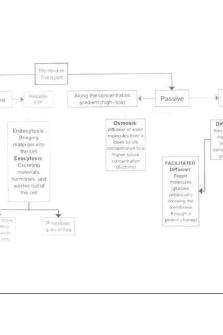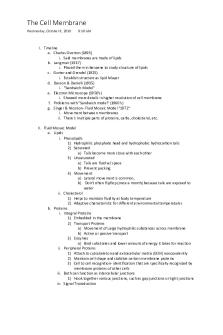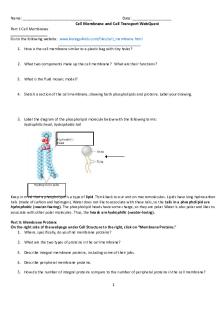Copy of Cell Membrane and Transport Coloring PDF

| Title | Copy of Cell Membrane and Transport Coloring |
|---|---|
| Author | Saul Sotolongo |
| Course | Biology of organisms |
| Institution | Loyola University New Orleans |
| Pages | 2 |
| File Size | 210.3 KB |
| File Type | |
| Total Downloads | 17 |
| Total Views | 183 |
Summary
Worksheet...
Description
Name:___________________________________________Date:_______
Cell Membrane and Transport Coloring The cell membrane is responsible for moving materials into and out of the cell. There are two types of transport that can occur across the membrane: passive transport and active transport. Passive transport does not require energy and includes the processes of osmosis, diffusion and facilitated diffusion. The graphic shows the phospholipid bilayer and embedded proteins, the two main components of the cell membrane. Phospholipids are made of hydrophilic (water-loving) heads and hydrophobic (water-hating) tails. The phospholipids are arranged opposite to each other, with the heads pointing toward the cell’s environment and the tails aligning to each other. Color all the phospholipids (c) of the membrane red. Some small molecules, like oxygen, can move right across the phospholipid bilayer through a process called diffusion. Diffusion occurs when molecules move from an area of high concentration to an area of low concentration. Color the oxygen molecules green . Some molecules are too large to pass through the membrane. Molecules likes glucose, which is a sugar molecule, must use special proteins embedded in the membrane to move into the cell. These proteins are called channel proteins, and they provide an opening, like a door, for large molecules to pass. Glucose will also move from areas of high concentration to low concentration, but because it needs the help of a protein, the process is called facilitated diffusion. Color all the glucose molecules (d) purple
. Color the channel protein (a) yellow
www.biologycorner.com
.
Osmosis is a Special Kind of Diffusion Osmosis is the process where water moves across the membrane toward the area with the highest solute concentration. A solute is a compound, like salt or sugar, that is dissolved in water. Hypertonic solutions have more solute in them, which cause water to move toward that area. Cells placed in hypertonic solutions will lose water and shrink. Solutions that have less solute molecules than the cell are called hypotonic. In this case, water from outside the cell will move into the cell. The cell will gain water, expand, and could even burst. To summarize, the side with MORE solute is said to be hypertonic, and the side with less is said to be hypotonic. Color the water molecules blue
, the solute molecules purple
and the phospholipids red
.
Water will move toward the area with the highest solute concentration.
1 What type of transport does not require energy? _________________________________________________ Provide an example of one process that is a type of passive transport? _____________________________ 2. What are the two main components of the cell membrane? _______________________________________ 3. How does oxygen cross into the cell?
__________________________________________________________
How does glucose cross into the cell? ________________________________________________________ 4. What is the purpose of a channel protein?___________________________________________ 5. What are the two parts of a phospholipid: ______________________________________________________ 6. Define diffusion. ___________________________________________________________________________ 7. Define osmosis: ___________________________________________________________________________ 8. What is a solute? ___________________________________________________________________________ 9. Hypertonic solutions have [ more / less ] solute. Hypotonic solutions have [ more / less ] solute. (circle) One the image above, which side is HYPERTONIC? [ left side | right side ] 10. What will happen to a cell placed in a hypertonic solution? _______________________________________ www.biologycorner.com...
Similar Free PDFs

Cell Membrane Coloring Worksheet
- 2 Pages

Membrane Transport Flow Chart
- 1 Pages

Cell Coloring Prokaryote
- 1 Pages

Cell Cycle Coloring Worksheet
- 2 Pages

Cell cycle coloring key
- 8 Pages

Week 2 Membrane transport lab
- 6 Pages

The Cell Membrane
- 2 Pages
Popular Institutions
- Tinajero National High School - Annex
- Politeknik Caltex Riau
- Yokohama City University
- SGT University
- University of Al-Qadisiyah
- Divine Word College of Vigan
- Techniek College Rotterdam
- Universidade de Santiago
- Universiti Teknologi MARA Cawangan Johor Kampus Pasir Gudang
- Poltekkes Kemenkes Yogyakarta
- Baguio City National High School
- Colegio san marcos
- preparatoria uno
- Centro de Bachillerato Tecnológico Industrial y de Servicios No. 107
- Dalian Maritime University
- Quang Trung Secondary School
- Colegio Tecnológico en Informática
- Corporación Regional de Educación Superior
- Grupo CEDVA
- Dar Al Uloom University
- Centro de Estudios Preuniversitarios de la Universidad Nacional de Ingeniería
- 上智大学
- Aakash International School, Nuna Majara
- San Felipe Neri Catholic School
- Kang Chiao International School - New Taipei City
- Misamis Occidental National High School
- Institución Educativa Escuela Normal Juan Ladrilleros
- Kolehiyo ng Pantukan
- Batanes State College
- Instituto Continental
- Sekolah Menengah Kejuruan Kesehatan Kaltara (Tarakan)
- Colegio de La Inmaculada Concepcion - Cebu








